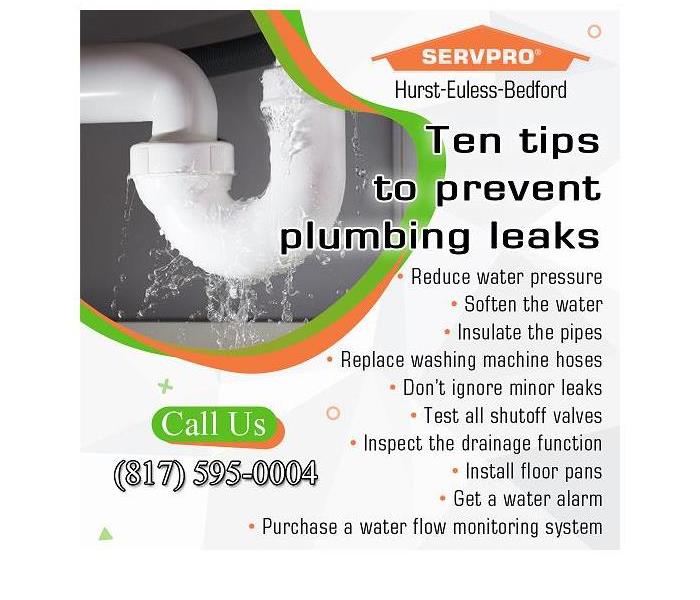SERVPRO shares 10 Steps Property Owners Can Take to Prevent Plumbing Leaks
6/17/2021 (Permalink)
Blog summary: This article by SERVPRO dives into the various preventive measures that businesses and homeowners can follow to prevent damage caused by plumbing leaks.
10 Tips to Prevent Plumbing Leaks
A plumbing system consists of much more than just the visible components – the sinks, faucets, water heaters, and drain pipes. An extensive network of supply and drain pipes is usually running within walls or floors or buried underground, hidden from the view.
A poorly maintained or neglected plumbing system in a commercial building or a home can lead to major leaks causing expensive water damage.
SERVPRO of Hurst-Euless-Bedford shares the common causes of plumbing leaks and the various measures business owners and homeowners can take to prevent them.
The common plumbing leak culprits are:
- Dishwashers
- Icemakers
- Water heaters
- Toilets
- Sinks
- Washing machines
- Showers and tubs
10 Preventive Steps
Reduce water pressure
As per experts, high water pressure simply reduces the life of plumbing as it stresses the pipe joints, faucets, and appliance valves. Water pressure can be measured with a hose bib gauge and should lie within 40-85 psi, normally. Anything above this range will put immense pressure on the plumbing and eventually give way to leaks.
- Soften the water
A high mineral content in water, known as hard water, slowly builds up minerals such as magnesium and calcium in the pipes. This leads to restriction of water flow, corrosion of joints and fittings, and increasing pressure.
Installing a water softener is the best method to combat hard water. Most softeners use sodium to counteract the minerals in the water, but there are electronic softeners that use only electromagnetic pulses to dissolve minerals.
Insulate the pipes
Pipes that are exposed to freezing temperatures or drafts can freeze and leak. It is advisable to insulate all exposed plumbing that is accessible and seal any external openings that allow frigid air to contact water supply lines. When temperatures drop below 25 degrees, the household thermostat should be set at 55 degrees or higher and taps should be left slightly open to allow water to dribble out as long as freezing temperatures persist.
Replace washing machine hoses
A leaky or ruptured washing machine hose is a common cause of leaks. Rubber hoses that supply water to washing machines have a lifespan of five years only. Therefore it is a good measure to replace rubber hoses before they leak and use braided stainless steel lines that are much more durable.
- Do not ignore minor leaks
Leakage of any magnitude is not normal. It is advised to do a visual inspection of all faucets, toilets, and exposed pipes as well as any signs of leaks where the pipes penetrate the walls or foundation. Small pools of water on the floor, water stains near the pipes, or warping of wallboard or paneling could indicate the presence of a leak.
All plumbing fixtures should be solidly attached to the floor or wall as the seals can break pipe connections. Even a pinhole in supply lines is a sign of internal corrosion that is a warning of the imminent bursting of pipes and severe flooding. These signs must be addressed immediately by a water damage restoration company.
- Test all shutoff valves
The location of the main water shutoff valve and how to operate it in emergencies must be common knowledge. Since valves often freeze in the open position due to the accumulation of mineral deposits, it is a good practice to test the main valve yearly to ensure it turns off and on easily. All individual shutoff valves such as those installed on the wall behind toilets and under sinks must also be tested.
- Inspect the drainage function
Water should travel easily down the drain pipes while creating a familiar swirl pattern as it enters the pipes. The appearance of bubbles or a gurgling sound during drainage could indicate a problem that needs to be corrected.
- Install floor pans
Floor pans under appliances are the first line of defense against water leakage. They cannot prevent catastrophic leaks but can prevent water damage from minor and slow leaks.
- Get a water alarm
Water alarms alert the inhabitants of a water threat. These sensors can be placed in basements, laundry rooms, bathrooms, kitchens, or next to the sump pump.
- Purchase a water flow monitoring system
A water flow monitoring system is protection for the complete property. It is attached to the water main and measures the water flow into the premises. In case of continuous water flow that is over and above the normal usage, the system will stop the flow of water automatically.
In case of water damage caused by plumbing leaks, property owners can get in touch with water damage restoration companies like SERVPRO of Hurst-Euless-Bedford.
Why SERVPRO?
- SERVPRO uses state-of-the-art equipment to bring the damaged property back to its original state. SERVPRO of Hurst-Euless-Bedford is always updating its fleet and equipment so clients in Hurst, Euless, Bedford, or anywhere else can quickly access the services.
- With over 1,700 US and Canadian Franchise locations, SERVPRO is strategically positioned to respond faster to an emergency of any magnitude.
- The SERVPRO staff is highly trained in property damage restoration. They receive initial in-house training and constant skill up-gradation at the corporate training facility and also acquire the regular IICRC-industry certification.
For water damage restoration services, call SERVPRO® of Hurst-Euless-Bedford today at (817) 595-0004 or e-mail at office@SERVPROheb.com






 24/7 Emergency Service
24/7 Emergency Service
